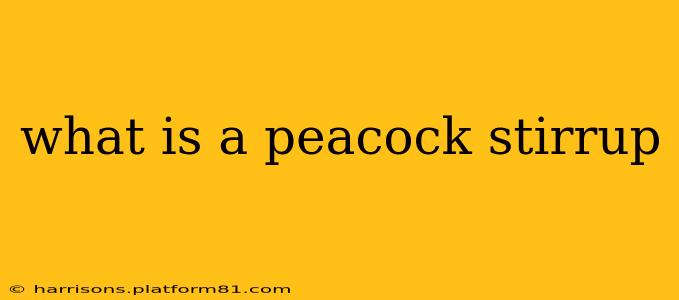The peacock stirrup, a captivating piece of equestrian history, is far more than just a functional riding accessory. Its intricate design and symbolic meaning elevate it to a status beyond mere utility, making it a fascinating subject for history buffs, art enthusiasts, and anyone captivated by the beauty of handcrafted objects. This article will explore the peacock stirrup, delving into its origins, design elements, and the cultural significance it holds.
What are the distinctive features of a peacock stirrup?
The name itself hints at the defining characteristic: the striking resemblance to a peacock's tail feathers. These stirrups are typically crafted from metal, often bronze or silver, and meticulously decorated with elaborate designs that mimic the iridescent plumage of a peacock. This isn't a simple, stamped-out pattern; instead, artisans painstakingly create incredibly detailed work, often employing techniques like repoussé and chasing to create a three-dimensional effect that captures the light and texture of the peacock's feathers. The "eyes" of the feathers are frequently emphasized, adding to the overall visual impact. The overall shape of the stirrup itself can vary, but the peacock tail motif is always the central and most prominent feature.
What materials were traditionally used to make peacock stirrups?
Historically, peacock stirrups were often made from bronze, a material prized for its durability and ability to hold intricate detail. Silver, and sometimes even gold, were used for more opulent and prestigious pieces, reflecting the high status of the rider or owner. The choice of metal often reflected the cultural context and the resources available to the craftsman. The techniques involved required a high level of skill and patience, highlighting the artistry involved in their creation.
Where did peacock stirrups originate, and when were they most prevalent?
Pinpointing the exact origin of peacock stirrups is difficult, as their production spanned numerous cultures and centuries. However, many examples are found in regions with a rich history of metalworking and equestrian traditions. They're commonly associated with certain periods in Asian history, particularly in regions like India, China, and Persia, where metalwork flourished and elaborate ornamentation was valued. While their precise timeline of creation varies by region, they were most prevalent during periods characterized by sophisticated craftsmanship and artistic patronage.
What is the cultural significance of peacock stirrups?
Beyond their aesthetic appeal, peacock stirrups hold considerable cultural significance. The peacock, itself, is a potent symbol across many cultures, often associated with royalty, immortality, and spiritual enlightenment. In some traditions, it represents beauty, pride, and even victory. Therefore, the use of the peacock motif on a stirrup suggests not only a keen appreciation for artistic craftsmanship but also a desire to embody or project these powerful symbolic meanings. The stirrups themselves, being essential riding equipment, further suggest the importance of horsemanship and equestrian skills within the relevant cultures.
How much are antique peacock stirrups worth?
The value of an antique peacock stirrup varies greatly depending on several factors, including the age, material, condition, provenance (history of ownership), and the intricacy of the design. Authentic pieces from notable historical periods or with exceptional craftsmanship can command very high prices in the art and antiques market. Collectors and museums actively seek out these rare and beautiful artifacts, driving up their value. It’s crucial to have any potential purchase authenticated by an expert to ensure its legitimacy and value.
Are there modern reproductions of peacock stirrups?
Yes, modern artisans continue to create reproductions of peacock stirrups, though these are generally distinguishable from antique pieces. While modern techniques may allow for efficient production, the skill and artistry of creating truly authentic-looking reproductions remain high. These reproductions offer a way for those interested in the aesthetic appeal to own a piece inspired by these historic items, without the costs associated with authentic antiques. However, discerning the difference between a reproduction and an antique piece requires a keen eye and knowledge of the historical production techniques.
In conclusion, the peacock stirrup is a captivating blend of artistry, history, and symbolism. Its intricate design and the cultural significance of the peacock make it more than just a functional object; it's a testament to human creativity and a window into the rich cultural heritage of various civilizations.
